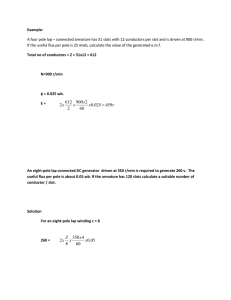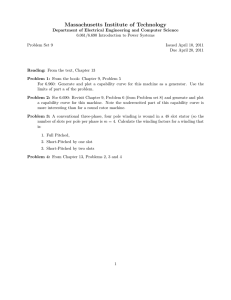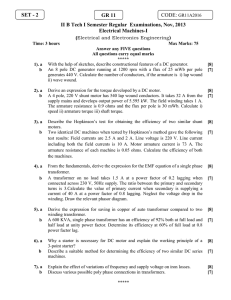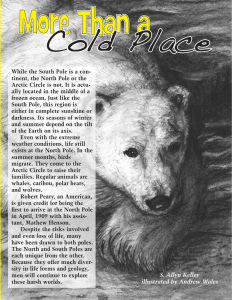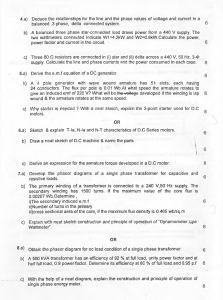Document
advertisement
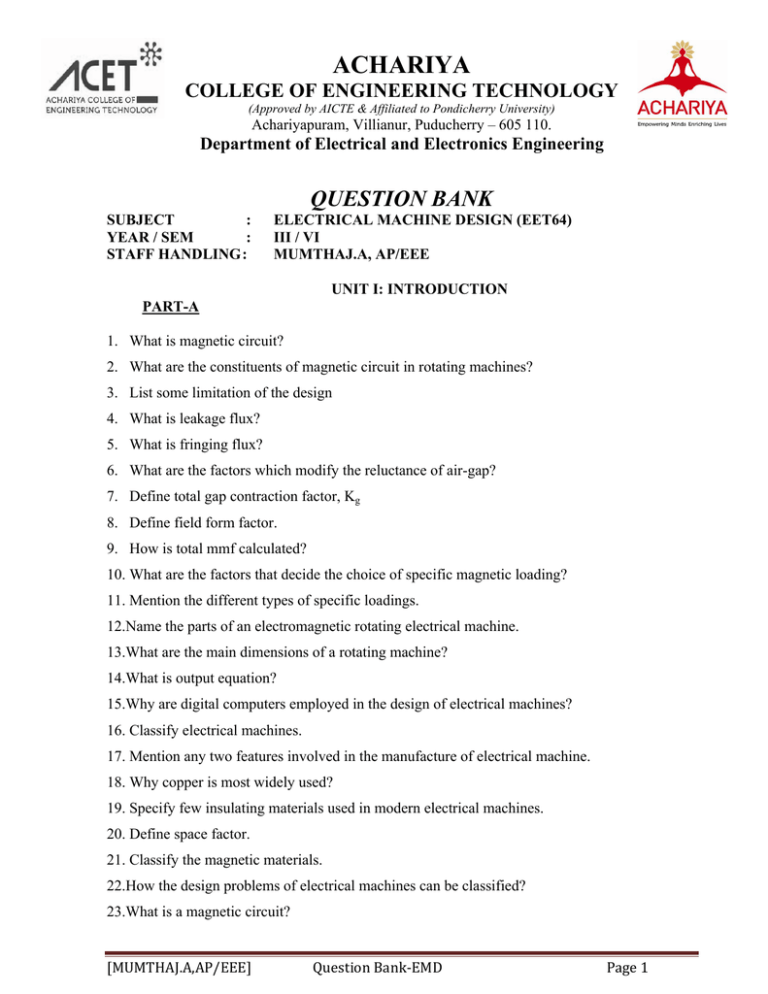
ACHARIYA COLLEGE OF ENGINEERING TECHNOLOGY (Approved by AICTE & Affiliated to Pondicherry University) Achariyapuram, Villianur, Puducherry – 605 110. Department of Electrical and Electronics Engineering QUESTION BANK SUBJECT : YEAR / SEM : STAFF HANDLING: ELECTRICAL MACHINE DESIGN (EET64) III / VI MUMTHAJ.A, AP/EEE UNIT I: INTRODUCTION PART-A 1. What is magnetic circuit? 2. What are the constituents of magnetic circuit in rotating machines? 3. List some limitation of the design 4. What is leakage flux? 5. What is fringing flux? 6. What are the factors which modify the reluctance of air-gap? 7. Define total gap contraction factor, Kg 8. Define field form factor. 9. How is total mmf calculated? 10. What are the factors that decide the choice of specific magnetic loading? 11. Mention the different types of specific loadings. 12.Name the parts of an electromagnetic rotating electrical machine. 13.What are the main dimensions of a rotating machine? 14.What is output equation? 15.Why are digital computers employed in the design of electrical machines? 16. Classify electrical machines. 17. Mention any two features involved in the manufacture of electrical machine. 18. Why copper is most widely used? 19. Specify few insulating materials used in modern electrical machines. 20. Define space factor. 21. Classify the magnetic materials. 22.How the design problems of electrical machines can be classified? 23.What is a magnetic circuit? [MUMTHAJ.A,AP/EEE] Question Bank-EMD Page 1 ACHARIYA COLLEGE OF ENGINEERING TECHNOLOGY (Approved by AICTE & Affiliated to Pondicherry University) Achariyapuram, Villianur, Puducherry – 605 110. Department of Electrical and Electronics Engineering 24.Write short notes on standard specifications 25.What is magnetization curve? 26.How the mmf of a magnetic circuit is determined? 27.Write the expression for the gap contraction factor for slots and ducts 28.Define field form factor. 29.Write down the formula for computing the mmf for the air gap length. 30.List the methods used for estimating the mmf for the teeth (tapered teeth) 31.State the relation between real and apparent flux density. 32.What is fringing flux? 33.Define permeance. PART-B 1. A 350 KW, 500V, 450rpm, 6-pole, dc generator is built with an armature diameter of 0.87m and core length of 0.32m. The lap wound armature has 660 conductors. Calculate the specific electric and magnetic loadings. 2. Calculate the MMF per meter for a flux density of 1.7wb/m and a permeability of 23.5 x 10- 6H/m. 3. The length of the iron path of a magnetic circuit is 50cm.the area of cross section is 12.5cm2 µr = 800, what is the reluctance of the magnetic circuit. 4. Calculate the mmf required for the air gap with kg = 1.1, Lg =2mm, Bg =1.5Wb/m2 5. Calculate the mmf required for one air gap of a dc machine with an axial length of 20 cm (no ducts) and a pole are 18 cm. The slot pitch is 27 mm, slot opening 12 mm, air gap 6 mm and the useful flux per pole 25 mWb. Take carter's coefficient for slot as 0.3. [MUMTHAJ.A,AP/EEE] Question Bank-EMD Page 2 ACHARIYA COLLEGE OF ENGINEERING TECHNOLOGY (Approved by AICTE & Affiliated to Pondicherry University) Achariyapuram, Villianur, Puducherry – 605 110. Department of Electrical and Electronics Engineering 6. A 15 KW, 230 V, 4- pole dc machine has the following data: armature diameter = 0.25 m, armature core length = 0.125 m, length of air gap at pole center = 2.5 mm, flux per pole = 11.7 x 10-3 Wb, (pole arc/pole pitch) = 0.66. Calculate the mmf required for air gap (i) if the armature surface is treated as smooth (ii) if the armature is slotted and the gap contraction factor is 1.18. 7. Determine the air-gap length of a dc machine from the following particulars: gross-length of core = 0.12m, number of ducts = one and is 10 mm wide, slot pitch = 25 mm, slot width = 10 mm, carter's coefficient for slots and ducts = 0.32, gap density at pole center = 0.7 Wb/m2; field mmf/pole = 3900 AT, mmf required for iron parts of magnetic circuit = 800AT, 8. The following data refers to a 20KW,2 pole DC motor ,Air gap =2.5mm,Area under each pole = 20x10-3m,air gap flux density =0.8wb/m2,vertical displacement of rotor =0.4mm.calculate the unbalanced magnetic pull acting downwards if the poles are located 45 degree with horizontal axis. 9. Calculate the unbalanced magnetic pull of 4 pole DC machine having air gap flux density of 0.85wb/m2, and a gap length of 2mm. the area of each pole is 24x10-3m2 and poles are symmetrically mounted. The accentricity is 15% in the air gap. 10. Calculate the apparent flux density at a section of the teeth of an armature of a DC machine from the following data at that section, slot pitch=24mm, slot width=tooth width=12mm, length of armature core including 5 ducts of 10mm each=0.38m, iron stacking factor=0.92, true flux density in teeth at that section is 2.2wb/m2 for which the mmf is 70,000AT/m. 11. Find the permeability at the root of the teeth of a DC machine armature from the following data, slot pitch 2.1cm,tooth width at the root 1.07cm,gross length 32cm,stacking factor=0.9 real flux density at the root of the teeth 2.25tesla,apparent flux density at the root 2.36tesla. [MUMTHAJ.A,AP/EEE] Question Bank-EMD Page 3 ACHARIYA COLLEGE OF ENGINEERING TECHNOLOGY (Approved by AICTE & Affiliated to Pondicherry University) Achariyapuram, Villianur, Puducherry – 605 110. Department of Electrical and Electronics Engineering 12. Calculate the mmf for air gap in a three phase induction motor from the following data stator bore 500mm,core length = 220mm,stator slots 76,rotor slots 94,slot opening 2mm,air gap length 0.9mm,take Kgd=1.15 and air gap flux density 0.54wb/m2 13. Explain the method of determining mmf for airgap of a salient pole machine. 14. Explain about (a). Analysis method (b). Synthesis method. 15. What are standard specifications? Write down the specification of a transformer. 16. Explain the advantages of the digital computer in design. 17. Write down the limitations in the design of electrical machine design. 18. Explain the recent trends in the design. 19. Write short notes on the principle of electrical machine design. 20. Calculate mmf required for the airgap of a machine having core length of 0.32m including 4 ducts of 10mm each,pole are of 0.29m,slot pitch of 65.4mm,slot opening of 5mm, airgap length of 5mm,flux per pole of 52m wb,given carter’s co-efficient is 0.18 for opening /gap = 1 and is 0.28 opening / gap = 2. UNIT II: DC MACHINES PART-A 1. List the constructional elements of a dc machine. 2. What is the relation between the power developed in armature and the power output in the dc machine? 3. What are the factors to be considered for the selection of number of poles in dc machine? 4. What are the factors to be considered for the choice of specific magnetic loading? 5. What are the factors that influence the choice of specific electric loading? 6. What are the advantages of large length of air gap in DC machine? 7. What is the purpose of constructing the pole body by laminated sheets? 8. List the advantages of large number of poles 9. Mention the two types of winding used in the dc machines. [MUMTHAJ.A,AP/EEE] Question Bank-EMD Page 4 ACHARIYA COLLEGE OF ENGINEERING TECHNOLOGY (Approved by AICTE & Affiliated to Pondicherry University) Achariyapuram, Villianur, Puducherry – 605 110. Department of Electrical and Electronics Engineering 10. What is meant by commutation? 11. What are the factors to be considered for the design of commutator? 12. What are the materials used for brushes in dc machines? 13. What is the need for brushes in dc machine? 14. What are the effects of armature reaction? 15. What are the factors to be considered in the design of commutator? 16. What are the materials used for brushes in DC machines? 17. Compare lap winding and wave winding. 18. How is the length of the commutator designed? 19. What the losses at the commutator surface? PART-B 1. Define the terms specific electric loading and specific magnetic loading as applied to electrical machines. What are the considerations in the choice of these for D.C machines? 2. Derive an output equation for a D.C machine. 3. Discuss the factors that go into the selection of number of poles for a DC machine. 4. Find the main dimensions of a 200KW, 250V, 6 pole, 1000 rpm generator. The maximum value of flux density in the gap is 0.87 Wb/m2 and the ampere conductors per metre of armature periphery are 31000. The ratio of pole arc to pole pitch is 0.67 and the efficiency is 91 percent. Assume the ratio of length of core to pole pitch = 0.75 5. Find the main dimensions and the number of poles of a 37 KW, 230V, 1400 rpm shunt motor so that a square pole face is obtained. The average gap density is 0.5 Wb/m2 and the ampere conductors per metre are 22000. The ratio of pole arc to pole pitch is 0.7 and the full load efficiency is 90 percent. 6. Calculate the main dimensions of a 20Hp, 1000 rpm, 400V, dc motor. Given that bav = 0.37 Wb/m2 and ac = 16000 amp.cond./m. Assume an efficiency of 90%. [MUMTHAJ.A,AP/EEE] Question Bank-EMD Page 5 ACHARIYA COLLEGE OF ENGINEERING TECHNOLOGY (Approved by AICTE & Affiliated to Pondicherry University) Achariyapuram, Villianur, Puducherry – 605 110. Department of Electrical and Electronics Engineering 7. A 4 pole, 25 Hp, 500V, 600 rpm series motor has an efficiency of 82%. The pole faces are square and the ratio of pole arc to pole pitch is 0.67. Tak Bav= 0.55 Wb/m2 and ac = 17000 amp.cond./m. Obtain the main dimensions of the core and particulars of a suitable armature winding. 8. Draw the winding diagram in the developed form for a 4-pole, 12 slots simplex lap connected dc generator with commutator having 12 segments. Indicate the position of brushes. 9. Draw the winding diagram in developed form for a simplex lap wound 24 slots, 4 pole dc armature with 24 commutator segments. Show the position of brushes. 10. Draw the winding diagram for a 4-pole, 13 slots, simplex wave connected dc generator with a commutator having 13 segments. The number of coil sides per slot is 2. Indicate the position of brushes. 11. A 4 pole simplex wave wound armature has 25 slots and 25 coils. The commutator has 25 segments. Work out its winding details. 12. Design a suitable commutator for a 350 KW, 600 rpm, 440 V, 6 pole dc generator having an armature diameter of 0.75 m. The number of coils is 288. Assume suitable values wherever necessary. 13. Explain constructional details of DC Machines. UNIT III: TRANSFORMERS PART-A 1. 2. 3. 4. 5. 6. What are the constructional elements of a transformer? How the heat dissipates in a transformer? Give the expression for primary induced voltage in a transformer. Derive an expression for the resistance of the winding. . How is the leakage reactance of the winding estimated? What are the various types of Transformers? [MUMTHAJ.A,AP/EEE] Question Bank-EMD Page 6 ACHARIYA COLLEGE OF ENGINEERING TECHNOLOGY (Approved by AICTE & Affiliated to Pondicherry University) Achariyapuram, Villianur, Puducherry – 605 110. Department of Electrical and Electronics Engineering 7. What is transformer bank? 8. Distinguish between core and shell type transformer. 9. What is window space factor? 10. Write down the output equation for the1phase and 3 phase transformer 11. How will you select the emf per turn of a transformer? 12. What are the factors to be considered for choosing the type winding for a core 13. type transformer? 14. List some methods of cooling of transformers. 15. What are the factors to be considered for choosing the method of cooling? 16. Why transformer oil is used as a cooling medium? 17. Why cooling tubes are provided? 18. What is a breather? 19. Why silica gel is used in breather? 20. What is conservator? PART-B 1. 2. 3. 4. Derive the output equation of Single phase Transformers Explain Constructional Details of Transformer. Derive the output equation of Three phase Transformers. How do you estimate the no load current of a 3 phase transformer. 4. Calculate the core and window areas required for a 1000 KVA, 6600/400 V, 50 Hz, and single phase core type transformer. Assume a maximum flux density of 1.25 Wb/m2 and a current density of 2.5 A/mm2. Voltage/turn = 30 V. Window space factor = 0.32 5. Estimate the main dimensions including winding conductor area of a 3=phase, -y core type transformer rated at 300 KVA, 6600/440 V, 50 Hz. A suitable core with 3-steps having a circumscribing circle of 0.25 m diameter and a leg spacing of 0.4 m is available. Emf/turn = 8.5V, =2.5 A/mm2 Kw=0.28, Sf=0.9 (stacking factor). 6. Determine the dimensions of core and window for a 5 KVA, 50 Hz, 1-phase, core type transformer. A rectangular core is used with long side twice as long as short side. The window height is 3 times the width. Voltage per turn = 1.8 V. Space factor = 0.2, = 1.8 A/mm2, Bm = 1 Wb/m2 [MUMTHAJ.A,AP/EEE] Question Bank-EMD Page 7 ACHARIYA COLLEGE OF ENGINEERING TECHNOLOGY (Approved by AICTE & Affiliated to Pondicherry University) Achariyapuram, Villianur, Puducherry – 605 110. Department of Electrical and Electronics Engineering 7. The tank of 1250 KVA, natural oil cooled transformer has the dimensions length, width and height as 0.65 x 1.55 x 1.85 m respectively. The full load loss = 13.1 KW, loss dissipation due to radiations = 6 W/m2-0C, loss dissipation due to convection = 6.5 W/m2-0C, Improvement in convection due to provision to tubes = 40 %, Temperature rise = 400C, Length of each tube = 1 m, Diameter of tube = 50 mm. Find the number of tubes for this transformer. Neglect the top and bottom surface of the tank as regards the cooling. 8. A 250 KVA, 6600/400 v, 3-phase core type transformer has a total loss of 4800 watts on full load. The transformer tank is 1.25 m in height and 1m x 0.5 m in plan. Design a suitable scheme for cooling tubes if the average temperature rise is to be limited to 350 C. The diameter of the tube is 50 mm and are spaced 75 mm from each other. The average height of the tube is 1.05 m. UNIT IV: INDUCTION MOTORS PART-A 1. List the constructional elements of squirrel cage induction motor. 2. List the constructional elements of slip-ring induction motor. 3. What are the main dimensions of induction motor? 4. Why wound rotor construction is adopted? 5. What is rotating transformer? 6. What are the materials used for slip-rings and brushes in induction motor? 7. What are the factors to be considered for the choice of specific magnetic loading? 8. What are the factors to be considered for the choice of specific electric loading? 9. How the induction motor can be designed for best power factor? 10. What are the different types of stator windings in induction motor? 11. What is slot space factor? 12. Which part of induction motor has maximum flux density? What is the maximum value of flux density in that part? 13. What are the factors to be considered for estimating the length of air-gap in induction motor? 14. What are the advantage and disadvantage of larger air gap length in induction motor? [MUMTHAJ.A,AP/EEE] Question Bank-EMD Page 8 ACHARIYA COLLEGE OF ENGINEERING TECHNOLOGY (Approved by AICTE & Affiliated to Pondicherry University) Achariyapuram, Villianur, Puducherry – 605 110. Department of Electrical and Electronics Engineering 15. What is harmonic induction torque? 16. What are the methods adopted to reduce harmonic torques? 17. What are the different types of windings used for rotor of induction motor? 18. List the method to improve the power factor of an induction motor. 19. How the induction motor designed for best power factor? 20. Write the formula for air gap in case of three phase induction motor in terms of length and diameter. 21. What is crawling and cogging? 22. What is skewing? 23. What is the condition for obtaining the maximum torque in case of 3 phase induction motor? PART-B 1. Derive an expression for the output equation of induction motor. 2. Explain the constructional details of a three phase induction motor. 3. Determine the approximate diameter and length of stator core, the number of stator slots and the number of conductors for a 11 KW, 400V, 3, 4-pole, 1425 rpm, delta connected induction motor. Bav = 0.45 Wb/m2, ac=23000 amp. Cond/m, full load efficiency = 0.85, pf = 0.88, L/ = 1. The stator employs a double layer winding. 4. Determine the D and L of a 70 Hp, 415V, 3-phase, 50-Hz, star connected, 6 pole induction motor for which ac = 30000 amp.cond/m and Bav = 0.51 wb/m2. Take = 90 % and pf = 0.91. Assume = L. Estimate the number of stator conductors required for a winding in which the conduxtors are connected in 2-parallel paths. Choose a suitable number of conductors/ slots, so that the slot loading does not exceed 750 amp. cond. 5. Estimate the main dimensions, air-gap length, stator slots, stator turns per phase and cross sectional area of stator and rotor conductors for a 3-phase, 15 HP, 400 V, 6 pole, 50 Hz, 975 rpm, induction motor. The motor is suitable for star delta starting. Bav = 0.45 Wb/m2, ac = 20000 amp.cond/m, L\ = 0.85, = 0.9, pf = 0.85 [MUMTHAJ.A,AP/EEE] Question Bank-EMD Page 9 ACHARIYA COLLEGE OF ENGINEERING TECHNOLOGY (Approved by AICTE & Affiliated to Pondicherry University) Achariyapuram, Villianur, Puducherry – 605 110. Department of Electrical and Electronics Engineering 6. Design a cage rotor for a 40 HP, 3-phase, 400V,50 Hz, 6 pole, delta connected induction motor having a full load of 87% and a full load pf of 0.85. Take D = 33 cm and L = 17 cm. Stator slots – 54, conductors/slot = 14. Assume suitable the missing data if any. 7. A three phase induction motor has 54 stator slots with 8 conductors per slot and 72 rotor slots with 4 conductors per slots. Find the number of stator and rotor turns. Find the voltage across the rotor slip rings, when the rotor is open circuited and at rest. Both stator and rotor is star connected and a voltage of 400 volt is applied across the stator terminals. 8. Determine for a 250 KVA, 1100 V, 12 pole, 500 rpm, 3-phase alternator(1) air gap diameter, (2) core length, (3) Number of stator conductors, (4) Number of stator slots and (5) cross-section of stator conductors. Assuming average gap density as 0.6 Wb/m2 and specific electric loading of 30,000 amp cond/m. L/ = 1.5. UNIT V: ALTERNATORS PART-A 1. 2. 3. 4. 5. 6. 7. 8. 9. 10. 11. 12. Name the two types of synchronous machines. What is runaway speed? What are the factors to be considered for the choice of specific magnetic loading? What are the two types of poles used in salient pole machines? List the factors to be considered for the choice of number of slots What is the limiting factor for the diameter of synchronous machine? Write the expression for air-gap length in cylindrical rotor machine. What is Short Circuit Ratio (SCR)? What is magnetization curve? What is leakage flux? What is leakage coefficient? What are the differences between leakage flux and fringing flux? [MUMTHAJ.A,AP/EEE] Question Bank-EMD Page 10 ACHARIYA COLLEGE OF ENGINEERING TECHNOLOGY (Approved by AICTE & Affiliated to Pondicherry University) Achariyapuram, Villianur, Puducherry – 605 110. Department of Electrical and Electronics Engineering 13. 14. 15. 16. 17. 18. 19. Distinguish between cylindrical pole and salient pole construction. Mention the uses of damper windings in a synchronous machine. How the value of SCR affects the design of alternator. What are the advantages large air-gap in synchronous machine? What is the limiting factor for the diameter of synchronous machine? State three important features of turbo alternator rotors. What are the prime movers used for a) Salient pole alternator, b) Non salient pole alternator. PART-B 1. Deduce an expression for the output equation of a synchronous machine (alternator). 2. Explain design aspects for turbo Alternator 3. A 600 rpm, 50 Hz, 10000 V, 3 phase, synchoronous generator has the following design data. Bav = 0.48 Wb/m2, = 2.7 amp/mm2, slot space factor = 0.35, number of slots = 144, slot size = 120 x 20 mm, D = 1.92 m and L = 0.4 m. determine the KVA rating of the machine. 4. A 500KVA, 3.3kV, 50Hz, 600 rpm, 3 Phase salient pole alternator ahs 200 turns per phase. Estimate the length of the air gap if the average flux density is 0.55T, the ratio of pole arc to pole pitch is 0.65, short circuit ratio is 1.5, gap expansion factor is 1.15, mmf required for the gap is 80% of no0 load field mmf and the winding factor is 0.955. 5. Determine suitable stator dimensions for a 500KVA, 50Hz, 3Φ, alternator to run at 375 rpm. Take mean gap density over the pole pitch as 0.55T, the electric loading as 250 amp. conductors per cm and assume a peripheral speed not exceeding 35m/s. 6. For a 250KVA,1100V,12 pole,500rpm, 3-phase alternator.Determine air gap diameter,core length,number of stator conductor,number of stator slots and cross section of stator conductor .Assuming average gap density as 0.6wb/m2 and specific electric loading of 30000amp.cod/m, L/τ =1.5. [MUMTHAJ.A,AP/EEE] Question Bank-EMD Page 11 1 ELECTRICAL MACHINE DESIGN: CLASS WORK PROBLEMS III YEAR/EEE UNIT-I (INTRODUCTION) 1. A 350 KW, 500V, 450rpm, 6-pole, dc generator is built with an armature diameter of 0.87m and core length of 0.32m. The lap wound armature has 660 conductors. Calculate the specific electric and magnetic loadings. 2. Calculate the MMF per meter for a flux density of 1.7wb/m and a permeability of 23.5 x 10- 6H/m. 3. The length of the iron path of a magnetic circuit is 50cm.the area of cross section is 12.5cm2 µr = 800, what is the reluctance of the magnetic circuit. 4. Calculate the mmf required for the air gap with kg = 1.1, Lg =2mm, Bg =1.5Wb/m2 5. Calculate the mmf required for one air gap of a dc machine with an axial length of 20 cm (no ducts) and a pole are 18 cm. The slot pitch is 27 mm, slot opening 12 mm, air gap 6 mm and the useful flux per pole 25 mWb. Take carter's coefficient for slot as 0.3. 6. A 15 KW, 230 V, 4- pole dc machine has the following data: armature diameter = 0.25 m, armature core length = 0.125 m, length of air gap at pole center = 2.5 mm, flux per pole = 11.7 x 10-3 Wb, (pole arc/pole pitch) = 0.66. Calculate the mmf required for air gap (i) if the armature surface is treated as smooth (ii) if the armature is slotted and the gap contraction factor is 1.18. 7. Determine the air-gap length of a dc machine from the following particulars: gross-length of core = 0.12m, number of ducts = one and is 10 mm wide, slot pitch = 25 mm, slot width = 10 mm, carter's coefficient for slots and ducts = 0.32, gap density at pole center = 0.7 Wb/m2; field mmf/pole = 3900 AT, mmf required for iron parts of magnetic circuit = 800AT, 8. The following data refers to a 20KW,2 pole DC motor ,Air gap =2.5mm,Area under each pole = 20x10-3m,air gap flux density =0.8wb/m2,vertical displacement of rotor A.Mumthaj,AP/EEE Page 1 2 =0.4mm.calculate the unbalanced magnetic pull acting downwards if the poles are located 45 degree with horizontal axis. 9. Calculate the unbalanced magnetic pull of 4 pole DC machine having air gap flux density of 0.85wb/m2, and a gap length of 2mm. the area of each pole is 24x10-3m2 and poles are symmetrically mounted. The accentricity is 15% in the air gap. 10. Calculate the apparent flux density at a section of the teeth of an armature of a DC machine from the following data at that section, slot pitch=24mm, slot width=tooth width=12mm, length of armature core including 5 ducts of 10mm each=0.38m, iron stacking factor=0.92, true flux density in teeth at that section is 2.2wb/m2 for which the mmf is 70,000AT/m. 11. Find the permeability at the root of the teeth of a DC machine armature from the following data, slot pitch 2.1cm,tooth width at the root 1.07cm,gross length 32cm,stacking factor=0.9 real flux density at the root of the teeth 2.25tesla,apparent flux density at the root 2.36tesla. 12. Calculate the mmf for air gap in a three phase induction motor from the following data stator bore 500mm,core length = 220mm,stator slots 76,rotor slots 94,slot opening 2mm,air gap length 0.9mm,take Kgd=1.15 and air gap flux density 0.54wb/m2 UNIT-II 1. Find the main dimensions of a 200KW, 250V, 6 pole, 1000 rpm generator. The maximum value of flux density in the gap is 0.87 Wb/m2 and the ampere conductors per metre of armature periphery are 31000. The ratio of pole arc to pole pitch is 0.67 and the efficiency is 91 percent. Assume the ratio of length of core to pole pitch = 0.75 The length of the armature, L = 0.22 m 2. Find the main dimensions and the number of poles of a 37 KW, 230V, 1400 rpm shunt motor so that a square pole face is obtained. The average gap density is 0.5 Wb/m2 and the A.Mumthaj,AP/EEE Page 2 3 ampere conductors per metre are 22000. The ratio of pole arc to pole pitch is 0.7 and the full load efficiency is 90 percent. 3. Calculate the main dimensions of a 20Hp, 1000 rpm, 400V, dc motor. Given that bav = 0.37 Wb/m2 and ac = 16000 amp.cond./m. Assume an efficiency of 90%. 4. A 4 pole, 25 Hp, 500V, 600 rpm series motor has an efficiency of 82%. The pole faces are square and the ratio of pole arc to pole pitch is 0.67. Tak Bav= 0.55 Wb/m2 and ac = 17000 amp.cond./m. Obtain the main dimensions of the core and particulars of a suitable armature winding. 5. Draw the winding diagram in the developed form for a 4-pole, 12 slots simplex lap connected dc generator with commutator having 12 segments. Indicate the position of brushes. 6. Draw the winding diagram in developed form for a simplex lap wound 24 slots, 4 pole dc armature with 24 commutator segments. Show the position of brushes. 7. Draw the winding diagram for a 4-pole, 13 slots, simplex wave connected dc generator with a commutator having 13 segments. The number of coil sides per slot is 2. Indicate the position of brushes. 8. A 4 pole simplex wave wound armature has 25 slots and 25 coils. The commutator has 25 segments. Work out its winding details. 9. Design a suitable commutator for a 350 KW, 600 rpm, 440 V, 6 pole dc generator having an armature diameter of 0.75 m. The number of coils is 288. Assume suitable values wherever necessary. A.Mumthaj,AP/EEE Page 3 4 UNIT-III 1. Calculate the core and window areas required for a 1000 KVA, 6600/400 V, 50 Hz, and single phase core type transformer. Assume a maximum flux density of 1.25 Wb/m2 and a current density of 2.5 A/mm2. Voltage/turn = 30 V. Window space factor = 0.32 2. Estimate the main dimensions including winding conductor area of a 3=phase, -y core type transformer rated at 300 KVA, 6600/440 V, 50 Hz. A suitable core with 3-steps having a circumscribing circle of 0.25 m diameter and a leg spacing of 0.4 m is available. Emf/turn = 8.5V, =2.5 A/mm2 Kw=0.28, Sf=0.9 (stacking factor). 3. Determine the dimensions of core and window for a 5 KVA, 50 Hz, 1-phase, core type transformer. A rectangular core is used with long side twice as long as short side. The window height is 3 times the width. Voltage per turn = 1.8 V. Space factor = 0.2, = 1.8 A/mm2, Bm = 1 Wb/m2 4. The tank of 1250 KVA, natural oil cooled transformer has the dimensions length, width and height as 0.65 x 1.55 x 1.85 m respectively. The full load loss = 13.1 KW, loss dissipation due to radiations = 6 W/m2-0C, loss dissipation due to convection = 6.5 W/m2-0C, Improvement in convection due to provision to tubes = 40 %, Temperature rise = 400C, Length of each tube = 1 m, Diameter of tube = 50 mm. Find the number of tubes for this transformer. Neglect the top and bottom surface of the tank as regards the cooling. 5. A 250 KVA, 6600/400 v, 3-phase core type transformer has a total loss of 4800 watts on full load. The transformer tank is 1.25 m in height and 1m x 0.5 m in plan. Design a suitable scheme for cooling tubes if the average temperature rise is to be limited to 350 C. The diameter of the tube is 50 mm and are spaced 75 mm from each other. The average height of the tube is 1.05 m. UNIT-IV 1. Determine the approximate diameter and length of stator core, the number of stator slots and the number of conductors for a 11 KW, 400V, 3, 4-pole, 1425 rpm, delta connected A.Mumthaj,AP/EEE Page 4 5 induction motor. Bav = 0.45 Wb/m2, ac=23000 amp. Cond/m, full load efficiency = 0.85, pf = 0.88, L/ = 1. The stator employs a double layer winding. 2. Determine the D and L of a 70 Hp, 415V, 3-phase, 50-Hz, star connected, 6 pole induction motor for which ac = 30000 amp.cond/m and Bav = 0.51 wb/m2. Take = 90 % and pf = 0.91. Assume = L. Estimate the number of stator conductors required for a winding in which the conduxtors are connected in 2-parallel paths. Choose a suitable number of conductors/ slots, so that the slot loading does not exceed 750 amp. cond. 3. Estimate the main dimensions, air-gap length, stator slots, stator turns per phase and cross sectional area of stator and rotor conductors for a 3-phase, 15 HP, 400 V, 6 pole, 50 Hz, 975 rpm, induction motor. The motor is suitable for star delta starting. Bav = 0.45 Wb/m2, ac = 20000 amp.cond/m, L\ = 0.85, = 0.9, pf = 0.85 4. Design a cage rotor for a 40 HP, 3-phase, 400V,50 Hz, 6 pole, delta connected induction motor having a full load of 87% and a full load pf of 0.85. Take D = 33 cm and L = 17 cm. Stator slots – 54, conductors/slot = 14. Assume suitable the missing data if any. 5. A three phase induction motor has 54 stator slots with 8 conductors per slot and 72 rotor slots with 4 conductors per slots. Find the number of stator and rotor turns. Find the voltage across the rotor slip rings, when the rotor is open circuited and at rest. Both stator and rotor is star connected and a voltage of 400 volt is applied across the stator terminals. 6. Determine for a 250 KVA, 1100 V, 12 pole, 500 rpm, 3-phase alternator(1) air gap diameter, (2) core length, (3) Number of stator conductors, (4) Number of stator slots and (5) cross-section of stator conductors. Assuming average gap density as 0.6 Wb/m2 and specific electric loading of 30,000 amp cond/m. L/ = 1.5. UNIT-V 1. A 600 rpm, 50 Hz, 10000 V, 3 phase, synchoronous generator has the following design data. Bav = 0.48 Wb/m2, = 2.7 amp/mm2, slot space factor = 0.35, number of slots = 144, A.Mumthaj,AP/EEE Page 5 6 slot size = 120 x 20 mm, D = 1.92 m and L = 0.4 m. determine the KVA rating of the machine. 2. A 500KVA, 3.3kV, 50Hz, 600 rpm, 3 Phase salient pole alternator ahs 200 turns per phase. Estimate the length of the air gap if the average flux density is 0.55T, the ratio of pole arc to pole pitch is 0.65, short circuit ratio is 1.5, gap expansion factor is 1.15, mmf required for the gap is 80% of no0 load field mmf and the winding factor is 0.955. 3. Determine suitable stator dimensions for a 500KVA, 50Hz, 3Φ, alternator to run at 375 rpm. Take mean gap density over the pole pitch as 0.55T, the electric loading as 250 amp. conductors per cm and assume a peripheral speed not exceeding 35m/s. 4. For a 250KVA,1100V,12 pole,500rpm, 3-phase alternator.Determine air gap diameter,core length,number of stator conductor,number of stator slots and cross section of stator conductor .Assuming average gap density as 0.6wb/m2 and specific electric loading of 30000amp.cod/m, L/τ =1.5. ************** All The Best ***************** A.Mumthaj,AP/EEE Page 6 ACHARIYA COLLEGE OF ENGINEERING TECHNOLOGY Electrical Machine Design Unit – I – 2 marks question and answers 1. What are the considerations to be made while designing a electrical machines? 1. Cost 2. Durability 3. Compliance with the performance specification and consumer requirement 2. List some limitation of the design 1. Magnetic Saturation 2. Temperature rise 3. Efficiency 4. Standard specifications 3. Define total magnetic loading. The total magnetic load is defined as the total flux around the armature periphery and is given by pϕ Weber’s 4. Define total electric loading The total armature ampere conductors around the armature periphery is known as the total electric loading and is given by IzZ 5. Define specific magnetic loading The specific magnetic loading is defined as the total flux per unit area over the surface of the armature periphery and is denoted by Bav also known as average flux density. 6. Define specific electric loading It is defined as the number of armature conductors per meter of armature periphery at the air gap. Specific electric loading=total number ampere conductors/armature periphery at air gap. 7. What are the factors that decide the choice of specific magnetic loading? 1. Maximum flux density in iron parts of machine 2. Magnetizing current 3. Core losses 8. What is the factors that decide the choice of specific electric loading. 1. Permissible temperature rise 2. Voltage rating of machine 3. Size of machine 4. Current densit 9. How the design problems of electrical machines can be classified? 1. Electromagnetic design MUMTHAJ.A,AP/ EEE ,ACET,PUDUCHERRY Page 1
